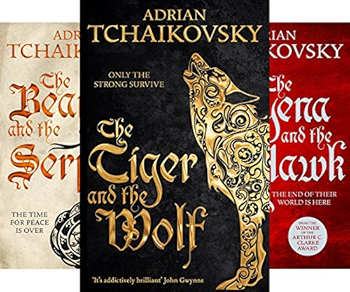
![]() The Tiger and the Wolf by Adrian Tchaikovsky
The Tiger and the Wolf by Adrian Tchaikovsky
The Tiger and the Wolf (2016), just issued in trade paperback format, immerses you a Bronze Age/early Iron Age world, where every human is a shapeshifter. People divide into clans according to the animal they change into, which happens instantly and, for the most part, at will. Their shapeshifting animal informs their clan’s physical appearance as well as the nature of their society. It’s a brutal life, with the stronger tribes like Tigers and Wolves fighting for supremacy. Groups like these dominate the weaker clans like the Deer and Boars, using them as subject people, servants and thralls, and even human/animal sacrifices.
In this harsh world, Maniye, a girl of the Winter Runner Wolf tribe in the northern area known as the Crown of the World, grows up isolated and friendless. Though her father is chieftain of their Wolf pack, he is distant and disapproving. Her mother was the queen of the Tigers, captured by the Wolves during the Tiger-Wolf wars and forced to marry Maniye’s father, Akrit Stone River, for political power. Akrit promptly had her killed off as soon as she produced a child. Because of her dual heritage, unlike most, Maniye can shapeshift or “Step” into the shape of either a Wolf or a Tiger, though only the Wolf priest in her tribe is aware of her secret.
Her dual spirit animals, however, cause issues with fitting in and conflict within Maniye’s soul, and in a moment of personal triumph she’s ready to disavow and bury the Tiger part of her and become pure Wolf. But hard on the heels of that proud moment comes her callous father’s disclosure of his plans for her, which finally pushes her over the edge. Maniye goes on the run, taking a Snake priest ― the Wolves’ latest planned sacrifice to their Wolf god ― with her. Her outraged father sends Broken Axe, his best hunter and his intended husband for Maniye, after her. As Maniye twists away from her intended fate, her actions cause ripples in the Crown of the World, and eventually not just the Wolves, but others, are seeking to capture her.
It’s a cruel but fascinating world, and Maniye has had a bleak life. As she travels, she finds loyalty and friendship, but also terrible brutality. She also finds that she can be much more, in both understanding and abilities, than she ever imagined. To some extent The Tiger and the Wolf is a coming of age novel, but it’s far more than that.
It’s a world where beliefs that initially sound like superstitions ― your name has power that can be taken from you; if you die in human form rather than in your animal form, your spirit may wander forever and be lost ― turn out to have a solid basis in fact. If you are collared around the neck, whether by a rope, a torc or the arm of an enemy, you are instantly forced to shift into human form and to stay that way until your neck is free. The animal gods worshipped by each tribe really do keep an eye on their doings, and will intervene if sufficiently motivated.
The worldbuilding here is impressive: There’s a clear echo of various historic Native American cultures in most of the tribes we see up close, but also a glimpse of some different cultures as well, suggesting that in the south there may be South American, African, or other influences. Each tribe is culturally distinct, some (the Tiger) with matriarchal societies, others (the Horse) with a trading-based culture. There’s a sense of history as well: bygone civilizations that built cities of carved stone; stories that once all people could shift into multiple animal shapes; tales of the Plague People that drove people to a new land; spiritual leaders foreseeing a time of war and great troubles to come.
It was an old tale, and she had heard it many times, in various incarnations. Not like this, though. Grey Herald spoke as though it was a true article of faith to him, deeply and directly relevant to every day of his living. This ancient tale had no dust on it, for him.
In the same way, The Tiger and the Wolf may be a story set in an ancient type of setting, but the themes it explores ― thirst for power or revenge, forgiveness, honor ― are relevant to each reader. This tale has no dust on it.
The Tiger and the Wolf didn’t appeal to me as much as Adrian Tchaikovsky‘s last novel, Guns of the Dawn, which hit my personal Jane Austen-esque sweet spot, but I tend to think that’s a limitation of my own tastes. This was a very different type of fantasy, set in a somber, conflict-driven world, with innumerable hand-to-hand fights (though: shapeshifting fights!), and with a deliberate pacing that at times can start to feel slow. I almost bogged down and gave it up, but in the end I’m very glad I didn’t. For the right reader, this is definitely a worthwhile, epic read. The sequel in this two-part series, The Bear and the Serpent, has just been published, and I hope to read it soon.



This sounds really interesting and imaginative!